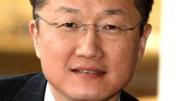The Associated Press has reported that President Barack Obama will nominate Jim Yong Kim, M.D. '91, Ph.D. '93, as the next president of the World Bank (a post for which Secretary of State Hillary Rodham Clinton and Eliot University Professor Lawrence H. Summers, a former Secretary of the Treasury and Harvard's president from 2001 to 2006, had been rumored as candidates). Kim, a co-founder with Kolokotrones University Professor of global health and social medicine Paul Farmer of Partners In Health, became president of Dartmouth College on July 1, 2009. There, drawing on his background at the World Health Organization and Partners in Health, he made global health a new institutional priority.
Harvard alumnus Jim Yong Kim nominated to lead World Bank
Harvard alumnus Jim Yong Kim nominated to lead World Bank
Harvard alumnus, now Dartmouth College president, takes on a new global role.

This report was updated at 4:15 p.m. to reflect corrections in Harvard's alumni records.
Related topics
You might also like
Harvard Students, Alumna Named Rhodes and Marshall Scholars
Nine Rhodes and five Marshall scholars will study in the U.K. in 2026.
Harvard’s Financial Challenges Lead to Difficult Choices
The University faces the consequences of the Trump administration—and its own bureaucracy
Harvard in the News
Grade inflation, Epstein files fallout, University database breach
Most popular
Explore More From Current Issue

The Trouble with Sidechat
No one feels responsible for what happens on Harvard’s anonymous social media app.

Harvard’s Financial Challenges Lead to Difficult Choices
The University faces the consequences of the Trump administration—and its own bureaucracy





